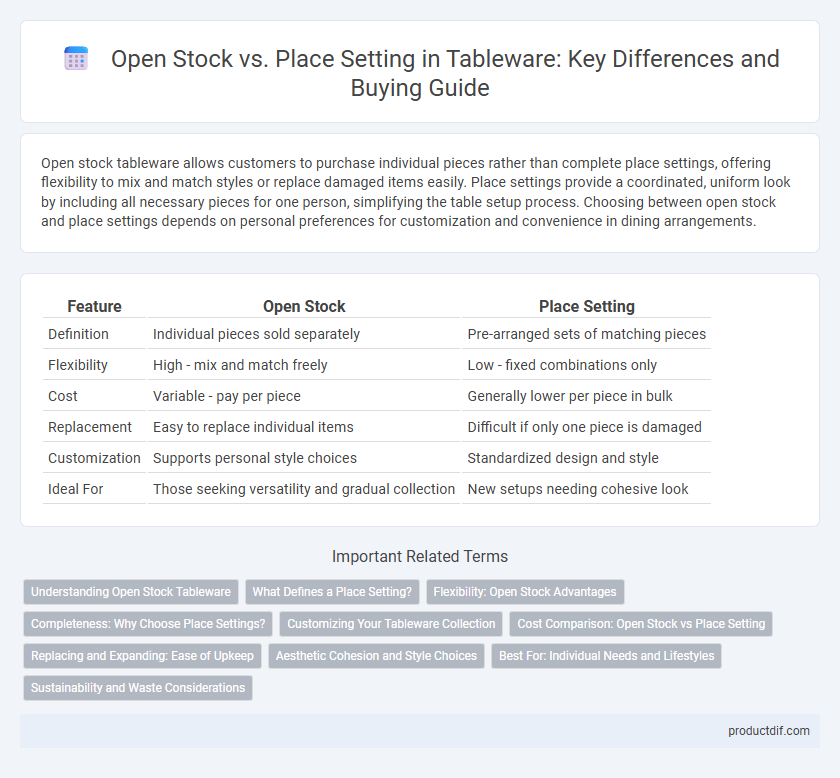Open stock tableware allows customers to purchase individual pieces rather than complete place settings, offering flexibility to mix and match styles or replace damaged items easily. Place settings provide a coordinated, uniform look by including all necessary pieces for one person, simplifying the table setup process. Choosing between open stock and place settings depends on personal preferences for customization and convenience in dining arrangements.
Table of Comparison
| Feature | Open Stock | Place Setting |
|---|---|---|
| Definition | Individual pieces sold separately | Pre-arranged sets of matching pieces |
| Flexibility | High - mix and match freely | Low - fixed combinations only |
| Cost | Variable - pay per piece | Generally lower per piece in bulk |
| Replacement | Easy to replace individual items | Difficult if only one piece is damaged |
| Customization | Supports personal style choices | Standardized design and style |
| Ideal For | Those seeking versatility and gradual collection | New setups needing cohesive look |
Understanding Open Stock Tableware
Open stock tableware allows businesses to purchase individual pieces rather than complete place settings, offering flexibility to replace or expand specific items without surplus inventory. This approach optimizes cost efficiency by tailoring orders to actual usage patterns and minimizing waste. Understanding open stock inventory management is essential for maintaining consistent tableware quality and availability in hospitality operations.
What Defines a Place Setting?
A place setting is defined by a coordinated arrangement of tableware pieces designed for an individual diner, typically including a dinner plate, salad plate, bowl, cup, and corresponding utensils. Unlike open stock, which allows for purchasing single pieces independently, place settings are pre-assembled collections ensuring uniform style and compatibility across all components. This cohesive design simplifies meal presentation and enhances the dining experience through consistent aesthetics and functionality.
Flexibility: Open Stock Advantages
Open stock tableware offers greater flexibility by allowing businesses to purchase individual pieces tailored to specific needs rather than entire place settings. This customization supports efficient inventory management and reduces waste by enabling easy replacement of broken or worn items without the need to buy full sets. Restaurants and catering services benefit from open stock's adaptability to varying guest counts and menu requirements, enhancing operational efficiency.
Completeness: Why Choose Place Settings?
Place settings offer a complete and coordinated collection of tableware items tailored for individual diners, ensuring uniformity and convenience during meal service. Unlike open stock, which requires purchasing pieces separately, place settings combine dinner plates, salad plates, bowls, and flatware into a cohesive set that matches in style and material. This comprehensive approach simplifies table setup and enhances the overall dining experience with consistent aesthetics and functionality.
Customizing Your Tableware Collection
Customizing your tableware collection involves choosing between open stock and place settings based on flexibility and specific needs. Open stock allows individual pieces to be selected and replaced, offering the advantage of tailoring your collection with unique items over time. Place settings provide a coordinated ensemble ideal for uniformity and convenience in serving multiple guests.
Cost Comparison: Open Stock vs Place Setting
Open stock tableware allows restaurants to purchase individual pieces, offering flexibility in replacing items and often resulting in cost savings by avoiding over-purchasing. Place settings, sold as complete sets, provide uniformity and ease in budgeting but can increase upfront expenses due to including surplus items not immediately needed. Comparing costs, open stock is typically more economical for establishments seeking tailored inventory control, while place settings suit those prioritizing consistency and simplicity in tableware management.
Replacing and Expanding: Ease of Upkeep
Open stock tableware allows for easy replacing of individual pieces, reducing costs and minimizing waste by matching exact items rather than entire place settings. Expanding tableware collections is more flexible since additional items can be added without disrupting existing sets. This approach simplifies upkeep and inventory management, ensuring consistent aesthetics and functionality over time.
Aesthetic Cohesion and Style Choices
Choosing open stock tableware allows for personalized aesthetic cohesion by mixing and matching individual pieces that reflect unique style preferences. Place settings offer uniformity and streamlined style choices, ensuring a consistent visual appeal across the table. Both options impact the overall ambiance, with open stock fostering creative expression and place settings emphasizing coordinated design.
Best For: Individual Needs and Lifestyles
Open stock tableware offers flexibility and customization, allowing consumers to select specific pieces that suit their individual needs and lifestyle, making it ideal for those who prefer varied styles or require replacements. Place settings provide a cohesive, pre-selected collection of dishes, perfect for individuals seeking convenience and a unified look for formal dining or everyday use. Choosing between open stock and place settings depends on personal preferences, lifestyle demands, and the need for versatility or consistency in tableware.
Sustainability and Waste Considerations
Open stock tableware allows for purchasing individual pieces, reducing excess inventory and minimizing waste by enabling users to replace only damaged or worn items. Place settings, typically sold in fixed sets, may lead to surplus items that go unused, increasing consumption and environmental impact. Opting for open stock supports sustainable practices by promoting efficient resource use and reducing landfill contributions.
Open Stock vs Place Setting Infographic

 productdif.com
productdif.com